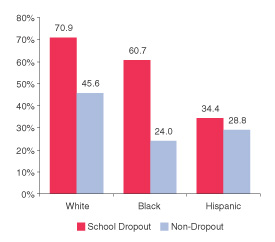
 |
| November 28, 2003 |
|
In Brief |
|
The National Survey on Drug Use and Health (NSDUH) includes questions about past and current school enrollment status. Two school enrollment categories were developed from these questions: school dropouts and non-dropouts. School dropouts completed less than the 12th grade, were not currently enrolled in school, and had not received either a high school diploma or a GED (general educational development) diploma. Non-dropouts included current high school students, high school graduates, college students, and college graduates.1
The survey also asks individuals about their use of cigarettes, alcohol, or illicit drugs during the month prior to the survey interview. Binge alcohol use is defined as drinking five or more drinks on the same occasion (i.e., at the same time or within a couple of hours of each other) on at least 1 day in the past 30 days. Heavy alcohol use is defined as drinking five or more drinks on the same occasion on 5 or more days in the past 30 days; all heavy alcohol users also are binge alcohol users. Any illicit drug refers to marijuana/hashish, cocaine (including crack), inhalants, hallucinogens, heroin, or prescription-type drugs used nonmedically.
Table 1. School Dropout Rates among Young Adults Aged 18 to 24, by Demographic Characteristics: 2002 |
Figure 1. Percentages of Young Adults Aged 18 to 24 Reporting Past Month Cigarette Use, by Race/Ethnicity and School Enrollment Category: 2002 |
 |
 |
Rates of binge alcohol use were similar among school dropouts (41 percent) and non-dropouts (39 percent). Among males, the binge drinking rate for school dropouts was the same as the rate for non-dropouts. However, among females, the rate of binge alcohol use was lower for school dropouts (24 percent) than non-dropouts (33 percent). Among blacks, school dropouts (39 percent) were more likely than non-dropouts (24 percent) to be binge alcohol users; however, among whites (45 vs. 47 percent) and Hispanics (33 vs. 36 percent), the rates of binge alcohol use were similar for school dropouts and non-dropouts. There was no difference in binge drinking among dropouts (35 percent) and non-dropouts (37 percent) aged 18 to 20. However, among those aged 21 to 24, dropouts were less likely to be binge alcohol users (41 percent) than non-dropouts (46 percent).
Overall, the rate of heavy alcohol use was lower among school dropouts compared with non-dropouts. Findings were similar for males and females. Among whites, school dropouts (16 percent) were less likely than non-dropouts (20 percent) to be heavy alcohol users, but there was no difference between school dropouts and non-dropouts among blacks. Among Hispanics, the rate of heavy alcohol use was 7 percent among school dropouts and 10 percent among non-dropouts, but this difference was not statistically significant. Although rates of heavy alcohol use were similar for school dropouts (12 percent) and non-dropouts (14 percent) aged 18 to 20, school dropouts aged 21 to 24 (12 percent) were less likely to be heavy alcohol users than same aged non-dropouts (18 percent).
Figure 2. Percentages of Young Adults Aged 18 to 24 Reporting Past Month Alcohol Use, by School Enrollment Category: 2002 |
Figure 3. Percentages of Young Adults Aged 18 to 24 Reporting Past Month Illicit Drug Use, by Race/Ethnicity and School Enrollment Category: 2002 |
 |
 |
Source (table and all figures): SAMHSA 2002 NSDUH.
| The National Survey on Drug Use and Health (NSDUH) is an annual survey sponsored by the Substance Abuse and Mental Health Services Administration (SAMHSA). Prior to 2002, this survey was called the National Household Survey on Drug Abuse (NHSDA). The 2002 data are based on information obtained from 68,126 persons aged 12 or older, including 20,478 adults aged 18 to 24. Of these, 2,165 were school dropouts. The survey collects data by administering questionnaires to a representative sample of the population through face-to-face interviews at their place of residence.
The NSDUH Report is prepared by the Office of Applied Studies (OAS), SAMHSA, and by RTI in Research Triangle Park, North Carolina. Information and data for this issue are based on the following publication and statistics: Office of Applied Studies. (2003). Results from the 2002 National Survey on Drug Use and Health: National findings (DHHS Publication No. SMA 03–3836, NHSDA Series H–22). Rockville, MD: Substance Abuse and Mental Health Services Administration. Also available on-line: http://www.oas.samhsa.gov. Additional tables available upon request. |
| The NSDUH Report (formerly The NHSDA Report) is published periodically by the Office of Applied Studies, Substance Abuse and Mental Health Services Administration (SAMHSA). All material appearing in this report is in the public domain and may be reproduced or copied without permission from SAMHSA. Additional copies of this report or other reports from the Office of Applied Studies are available on-line: http://www.oas.samhsa.gov. Citation of the source is appreciated. |
|
This page was last updated on December 30, 2008. |